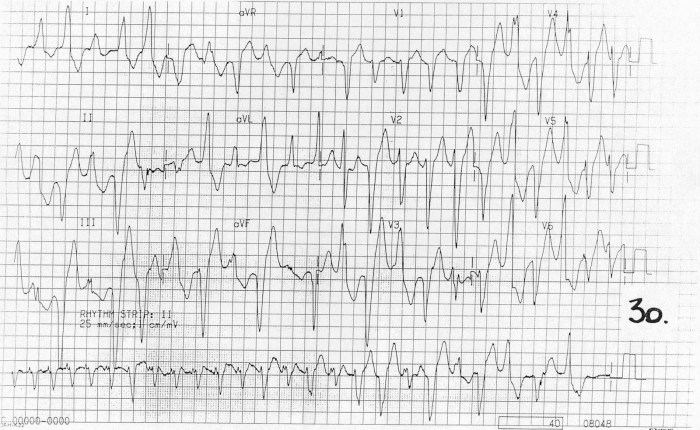This case is written by Dr. Kyla Caners. She is a PGY5 Emergency Medicine resident at McMaster University and is also one of the Editors-in-Chief here at EMSimCases.
Why it Matters
Digoxin toxicity is of critical importance to recognize. There are many subtleties to its management, which means that the concepts of digoxin toxicity are important to review. This case highlights some key features of chronic digoxin toxicity. In particular:
- The importance of considering digoxin toxicity in essentially all patients who take digoxin (due to its vague symptomatology)
- The classic ECG rhythm seen in toxicity: bidirectional VT
- The importance of treating digoxin toxicity early (and before a level is back) in the unstable patient with suspected toxicity
- How to dose digibind for management of toxicity
This case is likely to push the knowledge capacity of junior learners. For senior learners, the case could be modified to include a less pathognomonic rhythm at the case onset. For example, a slow a fib could be used. Rapidly alternating between fast and slow rhythms would be another excellent alternative.
Clinical Vignette
Mildred Funk is a 90 year old woman who is brought to the ED by her daughter because of confusion. She had some vomiting and diarrhea recently and hasn’t been eating or drinking much since. Today, she seems confused and keeps complaining that she’s dizzy to her daughter
Case Summary
A 90 year-old woman is brought to ED by her daughter because of confusion. She recently had a bought of vomiting and diarrhea and hasn’t been taking much PO since. Today, she is less responsive, seems confused, and is complaining of being dizzy. The team will be given a copy of the patient’s medication list, which will include digoxin. On arrival, the patient will be hypotensive and her rhythm will be bi-directional VT. Ideally, the team should give digibind. If they do not, they will receive blood work back with a high level to trigger administration.
Download the case here: Digoxin Overdose
ECG #1 for the case found here:

(ECG source: http://cdn.lifeinthefastlane.com/wp-content/uploads/2011/04/Bidirectional-VT.jpg)
ECG #2 for the case found here:

(ECG source: http://cdn.lifeinthefastlane.com/wp-content/uploads/2011/08/af1.jpg)
CXR for the case found here:

(CXR source: http://radiopaedia.org/articles/normal-position-of-diaphragms-on-chest-radiography)
How do you simulate bidirectional VT on your monitor? Is it built in to the manikin software you use? Do you use a separate program? I’ve had difficulty simulating a couple arrhythmias – notably this one and wide-complex afib – and would love it if you knew how to do it!
LikeLike
Hi Sara,
Great question! I agree that some rhythms are quite difficult to simulate on the monitor. In this case, I would have the monitor show either slow VT or multiple PVCs (eg – bigeminy) and then supply the learners with the necessary ECG. It’s not perfect, but it’s the best solution that I’ve found within the limitations of the technology we have to work with. Wouldn’t it be great if simulation software was a little more flexible when it came to rhythms?
Kyla
LikeLike